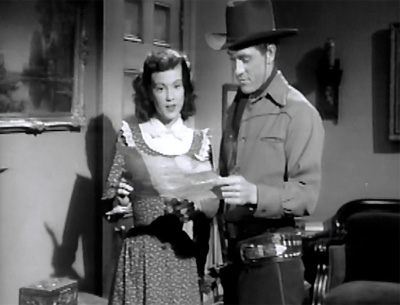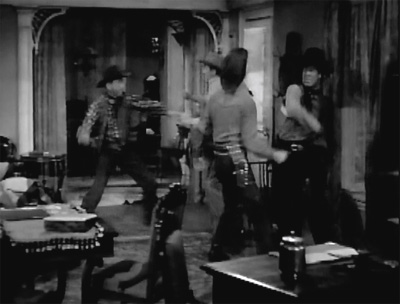Don Daredevil Rides Again Espaãƒâ±ol Latino

Republic, 12 Chapters, 1951. Starring Ken Curtis, Aline Towne, Roy Barcroft, Lane Bradford, Robert Einer, John Cason, Hank Patterson.
The citizens of a Western ranching customs suddenly find themselves dispossessed when an old Spanish land grant–nether which they agree championship to their ranches–is re-examined at the instigation of local attorney/politician Douglas Stratton (Roy Barcroft) and legally declared a forgery. Now, their property is costless land and belongs to the first homesteader who stakes a claim on it–and the land-grabbing Stratton is already planning to have his henchmen stake out as much valuable territory as they tin can. Still, lawyer Lee Hadley ((Ken Curtis) manages to file a claim on his cousin Patricia Doyle's (Aline Towne) property before Stratton's agents can, and encourages the other ranchers to exercise the same. To maintain championship to their new "claims," they must remain on the property for a yr–but Stratton is determined to make sure none of them stick effectually that long, and has his followers launch a reign of terror in hopes of driving off the ranchers. With the Sheriff in Stratton'due south pocket, Hadley finds legal remedies useless, and instead decides to follow the example of his grandfather–who one time combated outlawry equally the masked avenger "Don Daredevil." Equally the resurrected don, Hadley fights to protect his friends and neighbors from Stratton's gang, while too endeavoring to prove that Stratton engineered the whole free-land state of affairs by substituting a forgery for the original Castilian grant.
Don Daredevil Rides Again is in about regards a typical late Democracy serial; though total of stock footage and repetitiously plotted, its new footage is good enough and its running fourth dimension short plenty to brand it quite enjoyable. Dissimilar many of its contemporaries, information technology besides manages to successfully conceal its depression budget–since, every bit a Western, it's happily gratis from the over-aggressive sci-fi or espionage trappings of many other belatedly Republics.
Ronald Davidson'due south screenplay for Don Daredevil largely consists of a serial of encounters between Don Daredevil and Stratton's henchmen Weber and Hagen, with the masked human being continually contesting the heavies' attempts to destroy the homesteaders' property. The subplot of the forged land grant isn't utilized equally much as information technology could take been, although it does give rise to a cursory plot detour in Chapter Five, and plays an important part in the serial'south eventual denouement. Other detours are provided past the temporary arrest of Weber, the discovery of gold on one of the endangered homesteads, the villains' attempt to impale Lee Hadley, and the most-unmasking of Don Daredevil after Hadley is wounded; these deviations from the central storyline don't really overcome the repetitiveness of the serial'south narrative, but they exercise diminish it somewhat.

Above: Aline Towne and Ken Curtis examine the coveted land grant.
As any Republic serial buff will realize upon seeing the star's costume, Don Daredevil derives much of its stock footage from Zorro's Black Whip (most notably the shots of the Don riding to and from his waterfall hideout); Daredevils of the West and The Phantom Rider are represented as well. However, in typical Republic fashion, the borrowed shots are so smoothly combined with new ones that fifty-fifty a vitrify has to expect very advisedly to spot the seams. Some pieces of in-chapter action–like the attack on the wagons in the second episode or the buckboard chase in Chapter Five–depict on stock footage, but the bulk of the stock shows upwards in the chapter endings–among them the Affiliate 8 tent explosion (Whip), the Chapter Two cliff-autumn (Daredevils), and the Affiliate One cabin collapse (Rider). New cliffhangers are less spectacular, such every bit the hero'south credible knifing at the end of Chapter Five, the pitchforking in Affiliate Nine, or the shooting in Chapter X–although all three of these perils are resolved with above-average cleverness.


Above: Lane Bradford is nigh to pitchfork an unconscious Ken Curtis; the thought had been used earlier in Zorro's Black Whip, merely the footage is brand new.
Director Fred C. Brannon and the Democracy stunt team do a solid job with the new action scenes–although the screenplay forces them to stage a rather excessive number of barroom brawls (similar the oft-destroyed store in Haunted Harbor, the saloon in Don Daredevil is trashed and then oftentimes by battling heroes and villains that one wonders why it just doesn't shut down). Of these saloon fights, the best and most energetically staged is the Chapter Nine 1; this ball also begins in novel way, with Lee Hadley cagily managing to disarm a professional gunfighter who'southward trying to provoke him into a duel–and then energetically slugging information technology out with the killer on even terms. Tom Steele doubles the hero hither (and elsewhere); Dale Van Sickel plays the gunfighter.


To a higher place left: Tom Steele ducks beneath a table as Dale Van Sickel crashes a chair against information technology. In a higher place right: Ken Curtis (not doubled in this shot) finishes Van Sickel off with a beautiful haymaker; both shots are from the Chapter Nine fight.
Van Sickel also doubles for secondary hero Robert Einer and for activeness heavy Lane Bradford; Guy Teague can besides be seen doubling for Bradford in scenes that characteristic both the Einer and Bradford'south character–similar the four-homo ranch house fight in Chapter V, which features Steele, Van Sickel, Teague, and Carey Loftin (doubling secondary henchman John Cason) all battling away. Steele'southward fight with Eddie Parker (doubling Roy Barcroft) in Chapter Xi is likewise memorable, while Steele's various saloon slugfests with stuntmen Dave Sharpe, George Magrill, and Charles Horvath–though not as distinctive as the Chapter Nine ane with Van Sickel–are quite respectable.

Above: Guy Teague slugs Tom Steele in the foreground, while Carey Loftin (checkered shirt) and Dale Van Sickel square off in the groundwork.
The Chapter Three befouled fight (which concludes with a cursory merely interesting whip-versus-axe duel), Weber and Hagen's siege of the hero at a mine in Chapter Four, the shootout in the rocks in Chapter Seven, the gun battle betwixt homesteaders and merits-jumpers in Chapter Eight, and the satisfying climactic shootout at the Doyle ranch are good as well. The cliff and trails of Iverson's Ranch provide a backdrop for nigh all of the serial's outdoor action sequences, except for scenes like the opening shootout (which, like the satisfying finale, takes identify at Commonwealth's own backlot ranch).

To a higher place: John Cason and Lane Bradford chase cover at Iverson'south Ranch as Robert Einer (whose gunsmoke alone is visible here) fires at them from above.
Star Ken Curtis displays piffling of the exuberance that marked his later "Festus Haggen" characterization on the Gunsmoke TV show; here, he comes off as decidedly serious and subdued. Though somewhat lacking in affability, he's even so quite likable–and handles other key aspects of the hero's role very well, carrying both grim toughness (when confronting crooks) and shrewd intelligence (in bits like the showdown with the gunfighter or in the powder-butt scene in the concluding affiliate). His gaunt confront, thoughtful expressions, and dull drawl give him a rather Lincoln-like air at times–quite advisable for a supposed lawyer.

Above: Ken Curtis confronts Dale Van Sickel (back to photographic camera).
Heroine Aline Towne's quiet cheerfulness helps to residual out Curtis's somberness; she manages to come off as both calmly reflective and warmly earnest when joining him in discussions of strategy. Alternately clad in a riding skirt or old-fashioned clothes–and wearing her hair long and flowing–she likewise looks lovelier hither than in whatever of her other Republic outings (in which she was typically confined to business suits and outer-space coveralls)–although, as in virtually of her serials, she has fairly little to practise across conferring with the hero. Wonderful character histrion Hank Patterson, as the trusty old cowpoke Buck, makes a welcome addition to the cast of good guys; similar Towne, he spends nearly of his screen time at the Doyle ranch, merely he even so enlivens many a dialogue sequence with his feisty grumblings. His urging of Hadley to accept up the mantle of "ol' Don Daredevil" in the first chapter is most enjoyable, while his confrontation with Stratton and the Sheriff in Chapter Ten is one of the series'due south best moments.

Above: Aline Towne and Hank Patterson disgustedly bargain with sheriff I. Stanford Jolley.
Robert Einer plays the serial's fourth principal protagonist–young rancher Gary Taylor, who's unaware of Don Daredevil'southward identity, but does his all-time to assist him. Unlike nigh of the secondary heroes in Republic's serials, Gary is non a stolidly dependable fill-in for the hero; instead, scripter Davidson writes the character as an impetous hothead, using his loose-cannon behavior to provide a convenient but unusual catalyst for much of the action (and, incidentally, furnish i of Republic'south few genuinely funny fadeout scenes). Einer's performance in the part has been panned as "weak" by almost reviewers, but I notice it hard to agree with them; though he generally come off every bit doltish and awkward instead of heroic, such an approach seems ideally suited to the young blunderer he'south playing. He also manages to be suitably belligerent (every bit in his angry disputes with the heavies) and self (as when he confidently assures the heroine he can handle potential trouble) when the state of affairs calls for it, simply doesn't overdo either belligerency or cockiness to an obnoxious extent.

Above: Robert Einer as the shoot-first, talk-after Gary.
Roy Barcroft is characteristically excellent equally the scheming Stratton; although the part gives him no opportunities to brandish the phony friendliness that characterized some of his other serial brains-heavy turns, he notwithstanding derives plenty of mileage from Stratton's confident outlines of his plans, his abrupt criticisms of his henchmen, and his unblushing attempts to overwhelm opponents with legal prevarications ("As an attorney, I clinch you.."). Every bit Weber and Hagen, Lane Bradford and John Cason make a outset-rate henchman duo; both are intimidatingly mean and muscular, but are different plenty in their screen personalities to exist an interesting team; Bradford's terse and clear dialogue commitment and his water ice-cold manner contrast nicely with Cason'south growling vocalism, thick Texas accent, and gruffly downward-to-earth begetting.

In a higher place, left to correct: Roy Barcroft, John Cason, and Lane Bradford.
I. Stanford Jolley makes the most of his occasional appearances equally the blustering and compromised Sheriff; Forrest Taylor is too lively in his brief scene as Gary's male parent (who, amusingly, seems about as imprudent as his son). Lee Phelps pops up equally Uncle Michael Doyle, the holder of the disputed state grant, and Gene Roth has a skilful bit every bit the genial but gabby old rancher who dooms himself by striking gold in Chapter Vii. Mike Ragan (aka Holly Bane) makes a rare appearance on the side of a correct as a homesteader, while character player George Lloyd is delightful in his plow as a shifty trader. The stunt team members all play various $.25, with Dale Van Sickel hands the most memorable in his same appearance as the quietly sinister gunfighter Dan Farley. Bud Osborne and Jack Ingram both announced equally shifty bartenders, and cowboy musician Cactus Mack pops up as an outlaw.
Don Daredevil Rides Again offers nothing new to the veteran series-watcher, but makes for pleasant viewing nonetheless; information technology's professionally crafted and full of likable actors–and is never hampered or embarrassed past its budget the way some of its contemporaries were. While The Invisible Monster fell short of beingness a sci-fi thriller, and Canadian Mounties vs. Atomic Invaders failed equally a Cold War espionage adventure, Don Daredevil hands realizes its more modest goals–and succeeds as a compact and enjoyable Western chapterplay.

Source: https://filesofjerryblake.com/2014/01/09/don-daredevil-rides-again/
0 Response to "Don Daredevil Rides Again Espaãƒâ±ol Latino"
Post a Comment